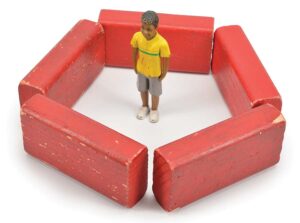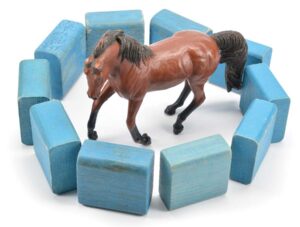Object inquiry skills, Problem-solving
A toddler sorts animal- and people-figure toys according to where they sleep.




Be Prepared: Select blocks that you and a toddler can use to build a simple house and a simple barn. Using a different color of blocks for each structure (without roofs) will help a toddler remember which building is a house (for people figures) and which building is a barn (for animal figures). Put the animal and people figures in a random arrangement on the table and the blocks in the middle of the table.
[Invite one toddler to play a sorting game with you at a low table. Sit facing the toddler. Point to people and animal figures and blocks when you name each.]
Today we can play a game called Where Do You Sleep? We have some little toys that look like people. We have some little toys that look like animals.
We also have blocks so we can build a house for people and a barn for animals. After we build a house and barn, we can put our people and animal toys where they live.
Will you help me build a house and a barn with our blocks?
[Support the toddler in constructing two simple structures that represent a house and a barn. Use different color blocks or noticeably different block arrangements for each, so it is easy for the toddler to tell which building is a house and which building is a barn. Do not put on roofs. Put the two structures near the toddler, leaving space for animal and people figures to be on the table near the two structures.]
Let’s pretend it is bedtime. It is time for our animal toys and our people toys to go to sleep. Our animal toys will sleep in the barn. Our people toys will sleep in the house.
[Put animal and people figures in a random arrangement near the barn and house structures, in front of the toddler so he/she can look at each one. It may be helpful for the toddler to change position at the table so there is easy access to the toy figures and the structures.]
Remember, our game is called Where Do You Sleep? For our game, you can look at each of our toys. Then you can put the toy where it goes to sleep.
 [Pick up a people toy without identifying it. Put the people toy near your face and ask the toy “Where do you sleep?”
[Pick up a people toy without identifying it. Put the people toy near your face and ask the toy “Where do you sleep?”
Hand the people toy to the toddler. Point to the house and barn when you mention each.]
[Encourage the toddler to put the people toy inside the house.]
 [Invite the toddler to pick up one toy at a time, look closely at the toy, and ask the toy “Where do you sleep?” Then encourage the toddler to put the toy in its appropriate structure.
[Invite the toddler to pick up one toy at a time, look closely at the toy, and ask the toy “Where do you sleep?” Then encourage the toddler to put the toy in its appropriate structure.
Offer verbal support as appropriate, such as a reminder “People sleep in the house. Animals sleep in the barn.”
Continue the game until all toy figures are sorted or the toddler loses interest.]
You did a lot of things! You helped build a house and a barn with our blocks. Then you looked closely at our toys. You asked “Where do you sleep?” but none of our toys answered you! You figured out whether a toy was a people toy or an animal toy. Where did you put the animal toys? Where did you put the people-figure toys?
Some toddlers may be more interested in the toy figures than in the sorting process. If this occurs, encourage the toddler to notice characteristics that are the same and different among the figures. Consider limiting the number of figures that you invite the toddler to sort.
A toddler may display humor in the game by placing an animal figure in the house for fun, knowing it is in the wrong place! Offer a comment that shows you appreciate the joke! Example: “Oh my, a cow in the house! Where would it sleep?” Playfully suggest the toddler move the animal to the barn.
Extra support
Enrichment
Object inquiry skills
Toddlers put together a group of animal counters of the same color and then sort counters by type of animal.




Be Prepared: Offer the activity at a low table that provides sufficient work space for each of four toddlers. Put the counters in a random arrangement in the middle of the table.
Invite four toddlers to help you put together animal counters that are the same color. Open the session by naming each of the colors represented among the counters. Also, name the types of animals in the collection of counters. Explain that today we will look at the color of our counters. We will not pay attention to the types of animals.
Explain that you are going to put together a group of counters that are the same color. Pick up four counters of the same color, one at a time, and put them in a small group in front of you or where all toddlers can easily see them. Explain your actions. Example: “Here is a red counter. I am going to put this red counter in my group. Here is another red counter. I am going to add this to my group of red counters.”
Pick up a fifth counter of a contrasting color that represents an animal already in your group. Add the different-color counter to your group of four counters of the same color. Ask toddlers “Is something wrong with this group of counters?” Assuming toddlers say “yes,” ask what is wrong. Build on toddlers’ responses to emphasize that the color of one counter is different from the color of the other counters. We want to put together a group of counters of the same color. Remove the different-color counter from your group and explain that now there is a group of counters of the same color.
Invite toddlers to put together their own group of counters of the same color. Help toddlers choose a color. Each toddler needs a different color. Encourage toddlers to pick up one counter of their designated color and put the counter in front of them. Describe (with pointing) what color each toddler is looking for. Then encourage toddlers to find more counters in the middle of the table that are the same color and put the counters in their group. Encourage toddlers to pick up one counter at a time. Explain that we are not in a hurry. We may need to wait for someone to take a counter from the middle of the table before we pick up a counter.
After toddlers have formed groups of counters of the same color, invite toddlers to put together the same types of animals in their group. This will lead to mostly groups of two counters of the same animal (and also same color). Offer a demonstration, if appropriate. Example: two pigs, two cows.
If toddler interest and time permit, encourage toddlers to put together another set of counters, this time with a color that was not the focus of their first round of sorting. Invite toddlers to put their counters in the middle of the table. Mix up the colors of counters in the arrangement.
Color is a strong interest of many toddlers at this age, and extending this interest to a simple sorting task is an achievable challenge for most toddlers. Finding a specific color in the collection of counters in the middle of the table will be most challenging at the beginning of the activity, when a relatively large collection of counters is available. You can impact this challenge by providing more or less space between counters in the middle of the table.
Look for opportunities to support toddlers in making the transition to putting together counters that represent the same animal (within each toddler’s group of the same color). This task requires toddlers to look more carefully at counter characteristics. The task also involves the self-regulation skill of shifting attention.
It may be helpful or necessary for you to facilitate turn-taking as toddlers wait for a peer to pick up a counter. Verbal support for picking up one counter at a time may be beneficial. See Extra Support tips.
Avoid asking toddlers how many counters they have in their group; numbers and counting are more appropriately introduced in the preschool years. Color names are an important part of the activity, but a toddler can readily participate without knowing all colors represented by the counters. Focus on the concepts of same and different in relation to color.
A Block 4 (Cognitive) activity involved sorting animal counters by color (Option 1) and type of animal (Option 3) in one-to-one settings. The current activity is slightly more challenging because it occurs in an informal gathering and involves the selection of counters from a larger collection of counters.
Extra support
Enrichment
Materials Needed: jumbo animal counters, bowls the color of animal counters
Extend Option 2 by putting the animal counters in a random arrangement in the center of a low table and placing the bowls in a circle around the counters. Invite several toddlers to put animal counters in the bowl that matches their color. Example: all red counters in the red bowl. Toddlers may want to choose one or two colors of counters they are responsible for matching to bowls. If you do not have an appropriately-colored bowl for each of the colors of counters, use bowls of the same color and place a small piece of cardstock inside each bowl that represents one of the colors (made by a marker or crayon). Invite several toddlers to help you make the colored pieces of cardstock.
Materials Needed: clean food cartons, baby toys, building toys, wallets, purses, keys, beads, muffin pans, plastic alphabet letters
In addition to offering Options 1 and 2, provide additional opportunities for toddlers to sort toys in your setting. One possibility is to help toddlers make a parking lot for toy vehicles and arrange vehicles in groups, such as toy trucks together and toy cars together. Also, when toddlers help put away toys, talk about what goes together. Focus on one area at a time. Example: “Our star builders go in the big container. Our soft blocks go together on the shelf.”
Preschool-age children may enjoy making a pretend store and organizing various items in groups, such as things for infants, things for parents, and things for older children. Provide clean food cartons, baby toys, books, building toys, wallets, purses, and keys.
Preschool-age and older children enjoy stringing beads. Provide a tray of assorted beads and talk with children about how the beads are the same and different. Some children may be interested in finding flower beads or sparkle beads for a necklace. On another day, provide a sorting activity with a bead tray and a muffin pan. Older children may enjoy sorting plastic alphabet letters into groups of uppercase and lowercase.
Present two identical toys to an infant who sits on his/her own. Talk with the infant about how the two toys are the same as he/she explores the toys.